Medication Error in NHS
VerifiedAdded on 2023/06/12
|11
|3324
|116
AI Summary
This article discusses the issue of medication errors in NHS, their causes, and solutions. It critically analyses a primary paper and provides evidence-based recommendations for healthcare professionals and organisations to ensure effective medication administration. The article also highlights the need for fair blame culture and proper education of nurses to reduce medication errors.
Contribute Materials
Your contribution can guide someone’s learning journey. Share your
documents today.
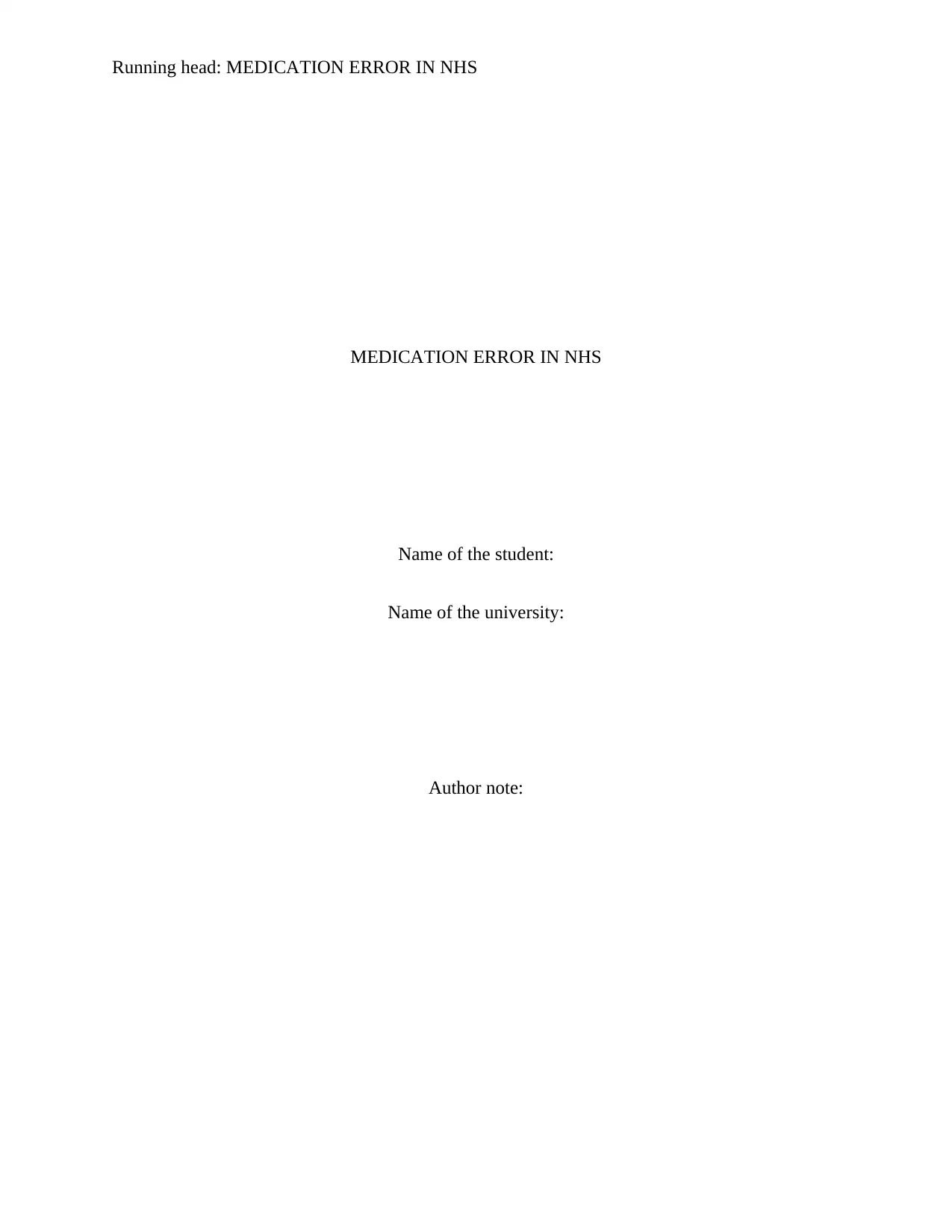
Running head: MEDICATION ERROR IN NHS
MEDICATION ERROR IN NHS
Name of the student:
Name of the university:
Author note:
MEDICATION ERROR IN NHS
Name of the student:
Name of the university:
Author note:
Secure Best Marks with AI Grader
Need help grading? Try our AI Grader for instant feedback on your assignments.
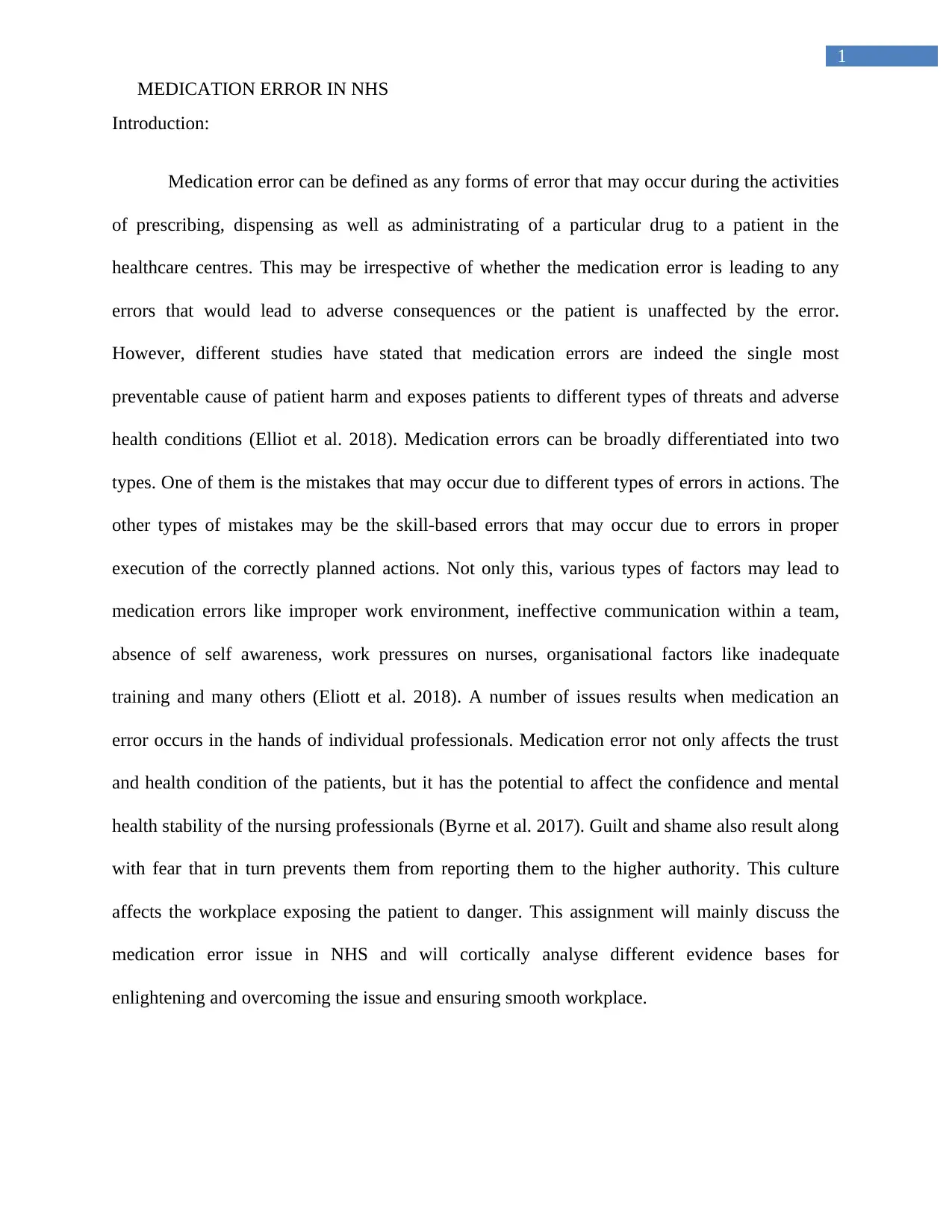
1
MEDICATION ERROR IN NHS
Introduction:
Medication error can be defined as any forms of error that may occur during the activities
of prescribing, dispensing as well as administrating of a particular drug to a patient in the
healthcare centres. This may be irrespective of whether the medication error is leading to any
errors that would lead to adverse consequences or the patient is unaffected by the error.
However, different studies have stated that medication errors are indeed the single most
preventable cause of patient harm and exposes patients to different types of threats and adverse
health conditions (Elliot et al. 2018). Medication errors can be broadly differentiated into two
types. One of them is the mistakes that may occur due to different types of errors in actions. The
other types of mistakes may be the skill-based errors that may occur due to errors in proper
execution of the correctly planned actions. Not only this, various types of factors may lead to
medication errors like improper work environment, ineffective communication within a team,
absence of self awareness, work pressures on nurses, organisational factors like inadequate
training and many others (Eliott et al. 2018). A number of issues results when medication an
error occurs in the hands of individual professionals. Medication error not only affects the trust
and health condition of the patients, but it has the potential to affect the confidence and mental
health stability of the nursing professionals (Byrne et al. 2017). Guilt and shame also result along
with fear that in turn prevents them from reporting them to the higher authority. This culture
affects the workplace exposing the patient to danger. This assignment will mainly discuss the
medication error issue in NHS and will cortically analyse different evidence bases for
enlightening and overcoming the issue and ensuring smooth workplace.
MEDICATION ERROR IN NHS
Introduction:
Medication error can be defined as any forms of error that may occur during the activities
of prescribing, dispensing as well as administrating of a particular drug to a patient in the
healthcare centres. This may be irrespective of whether the medication error is leading to any
errors that would lead to adverse consequences or the patient is unaffected by the error.
However, different studies have stated that medication errors are indeed the single most
preventable cause of patient harm and exposes patients to different types of threats and adverse
health conditions (Elliot et al. 2018). Medication errors can be broadly differentiated into two
types. One of them is the mistakes that may occur due to different types of errors in actions. The
other types of mistakes may be the skill-based errors that may occur due to errors in proper
execution of the correctly planned actions. Not only this, various types of factors may lead to
medication errors like improper work environment, ineffective communication within a team,
absence of self awareness, work pressures on nurses, organisational factors like inadequate
training and many others (Eliott et al. 2018). A number of issues results when medication an
error occurs in the hands of individual professionals. Medication error not only affects the trust
and health condition of the patients, but it has the potential to affect the confidence and mental
health stability of the nursing professionals (Byrne et al. 2017). Guilt and shame also result along
with fear that in turn prevents them from reporting them to the higher authority. This culture
affects the workplace exposing the patient to danger. This assignment will mainly discuss the
medication error issue in NHS and will cortically analyse different evidence bases for
enlightening and overcoming the issue and ensuring smooth workplace.
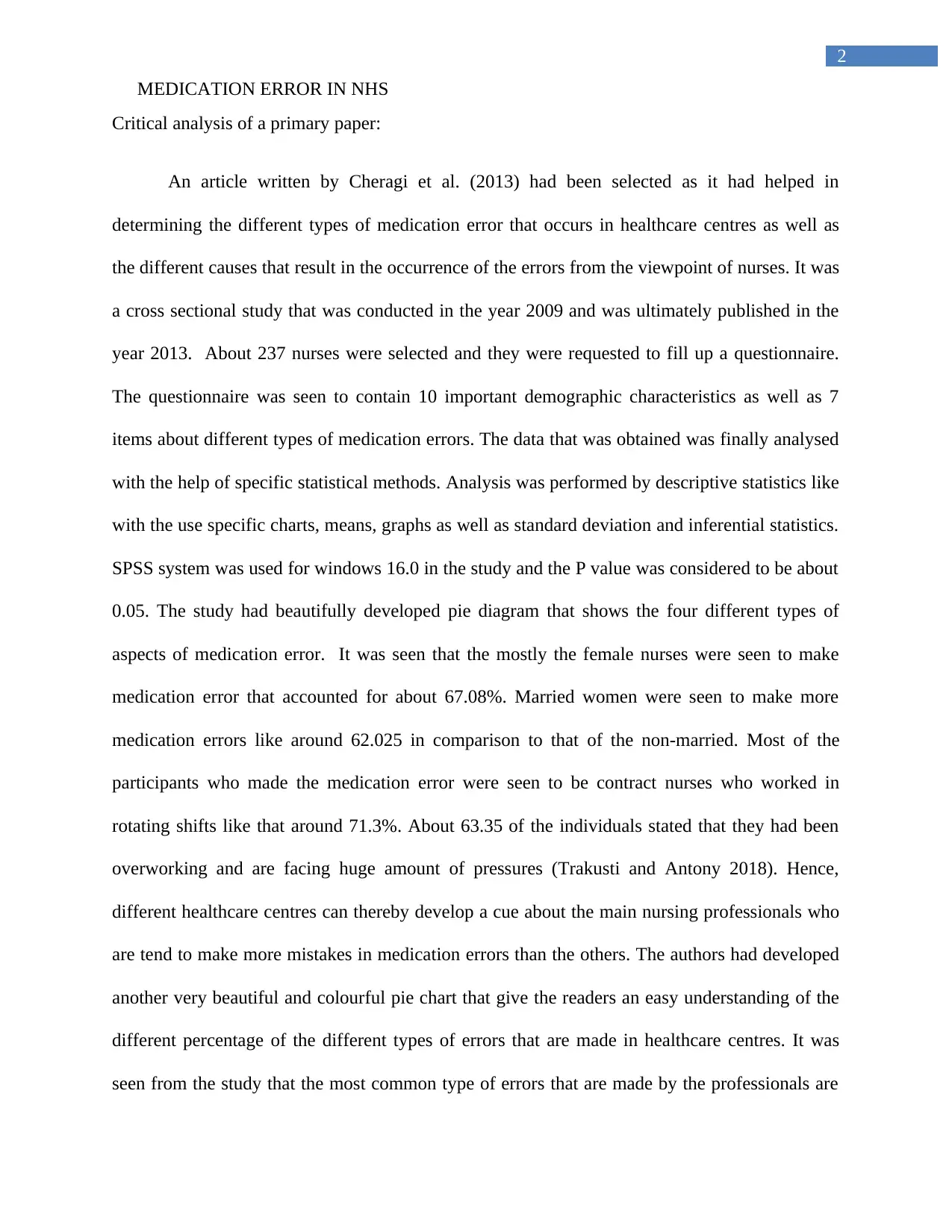
2
MEDICATION ERROR IN NHS
Critical analysis of a primary paper:
An article written by Cheragi et al. (2013) had been selected as it had helped in
determining the different types of medication error that occurs in healthcare centres as well as
the different causes that result in the occurrence of the errors from the viewpoint of nurses. It was
a cross sectional study that was conducted in the year 2009 and was ultimately published in the
year 2013. About 237 nurses were selected and they were requested to fill up a questionnaire.
The questionnaire was seen to contain 10 important demographic characteristics as well as 7
items about different types of medication errors. The data that was obtained was finally analysed
with the help of specific statistical methods. Analysis was performed by descriptive statistics like
with the use specific charts, means, graphs as well as standard deviation and inferential statistics.
SPSS system was used for windows 16.0 in the study and the P value was considered to be about
0.05. The study had beautifully developed pie diagram that shows the four different types of
aspects of medication error. It was seen that the mostly the female nurses were seen to make
medication error that accounted for about 67.08%. Married women were seen to make more
medication errors like around 62.025 in comparison to that of the non-married. Most of the
participants who made the medication error were seen to be contract nurses who worked in
rotating shifts like that around 71.3%. About 63.35 of the individuals stated that they had been
overworking and are facing huge amount of pressures (Trakusti and Antony 2018). Hence,
different healthcare centres can thereby develop a cue about the main nursing professionals who
are tend to make more mistakes in medication errors than the others. The authors had developed
another very beautiful and colourful pie chart that give the readers an easy understanding of the
different percentage of the different types of errors that are made in healthcare centres. It was
seen from the study that the most common type of errors that are made by the professionals are
MEDICATION ERROR IN NHS
Critical analysis of a primary paper:
An article written by Cheragi et al. (2013) had been selected as it had helped in
determining the different types of medication error that occurs in healthcare centres as well as
the different causes that result in the occurrence of the errors from the viewpoint of nurses. It was
a cross sectional study that was conducted in the year 2009 and was ultimately published in the
year 2013. About 237 nurses were selected and they were requested to fill up a questionnaire.
The questionnaire was seen to contain 10 important demographic characteristics as well as 7
items about different types of medication errors. The data that was obtained was finally analysed
with the help of specific statistical methods. Analysis was performed by descriptive statistics like
with the use specific charts, means, graphs as well as standard deviation and inferential statistics.
SPSS system was used for windows 16.0 in the study and the P value was considered to be about
0.05. The study had beautifully developed pie diagram that shows the four different types of
aspects of medication error. It was seen that the mostly the female nurses were seen to make
medication error that accounted for about 67.08%. Married women were seen to make more
medication errors like around 62.025 in comparison to that of the non-married. Most of the
participants who made the medication error were seen to be contract nurses who worked in
rotating shifts like that around 71.3%. About 63.35 of the individuals stated that they had been
overworking and are facing huge amount of pressures (Trakusti and Antony 2018). Hence,
different healthcare centres can thereby develop a cue about the main nursing professionals who
are tend to make more mistakes in medication errors than the others. The authors had developed
another very beautiful and colourful pie chart that give the readers an easy understanding of the
different percentage of the different types of errors that are made in healthcare centres. It was
seen from the study that the most common type of errors that are made by the professionals are
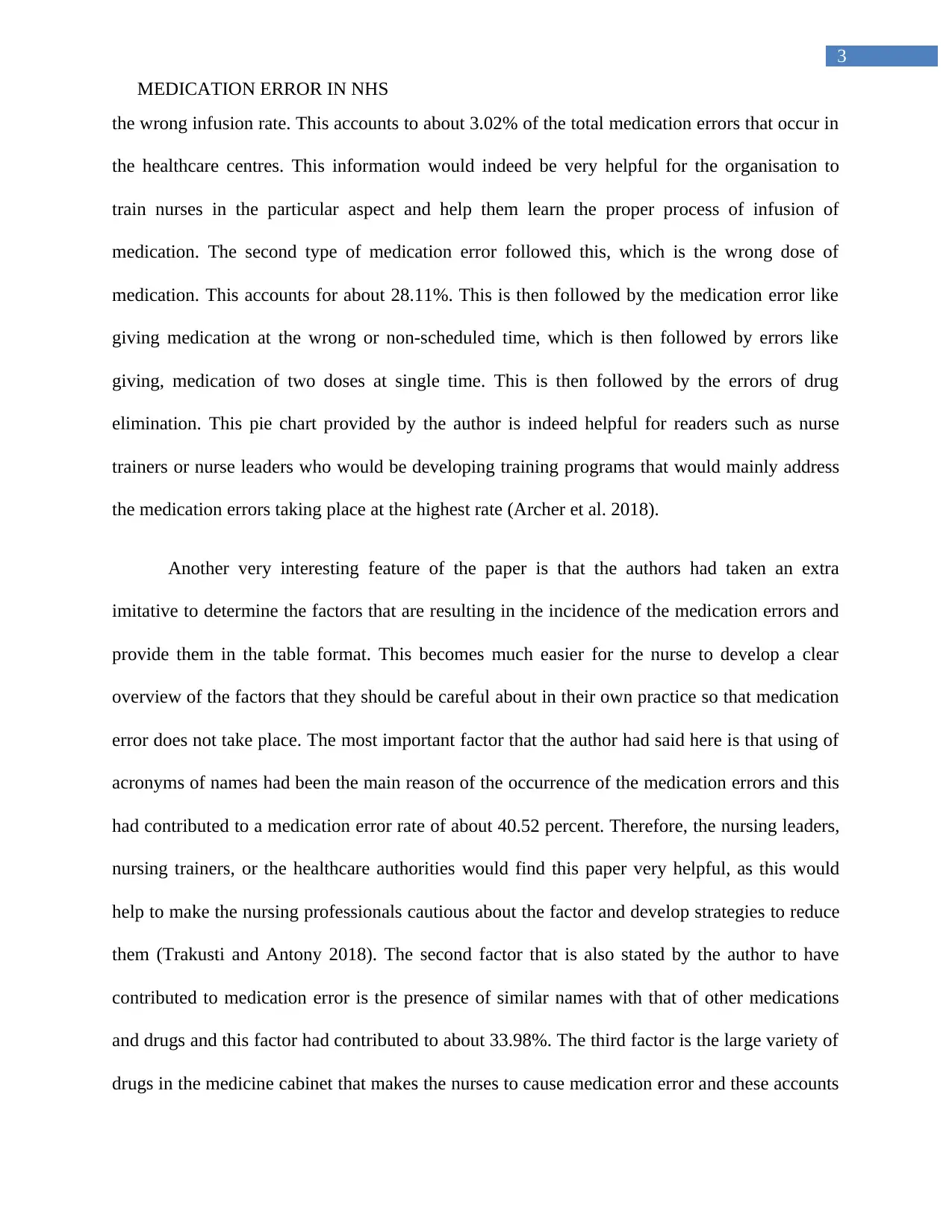
3
MEDICATION ERROR IN NHS
the wrong infusion rate. This accounts to about 3.02% of the total medication errors that occur in
the healthcare centres. This information would indeed be very helpful for the organisation to
train nurses in the particular aspect and help them learn the proper process of infusion of
medication. The second type of medication error followed this, which is the wrong dose of
medication. This accounts for about 28.11%. This is then followed by the medication error like
giving medication at the wrong or non-scheduled time, which is then followed by errors like
giving, medication of two doses at single time. This is then followed by the errors of drug
elimination. This pie chart provided by the author is indeed helpful for readers such as nurse
trainers or nurse leaders who would be developing training programs that would mainly address
the medication errors taking place at the highest rate (Archer et al. 2018).
Another very interesting feature of the paper is that the authors had taken an extra
imitative to determine the factors that are resulting in the incidence of the medication errors and
provide them in the table format. This becomes much easier for the nurse to develop a clear
overview of the factors that they should be careful about in their own practice so that medication
error does not take place. The most important factor that the author had said here is that using of
acronyms of names had been the main reason of the occurrence of the medication errors and this
had contributed to a medication error rate of about 40.52 percent. Therefore, the nursing leaders,
nursing trainers, or the healthcare authorities would find this paper very helpful, as this would
help to make the nursing professionals cautious about the factor and develop strategies to reduce
them (Trakusti and Antony 2018). The second factor that is also stated by the author to have
contributed to medication error is the presence of similar names with that of other medications
and drugs and this factor had contributed to about 33.98%. The third factor is the large variety of
drugs in the medicine cabinet that makes the nurses to cause medication error and these accounts
MEDICATION ERROR IN NHS
the wrong infusion rate. This accounts to about 3.02% of the total medication errors that occur in
the healthcare centres. This information would indeed be very helpful for the organisation to
train nurses in the particular aspect and help them learn the proper process of infusion of
medication. The second type of medication error followed this, which is the wrong dose of
medication. This accounts for about 28.11%. This is then followed by the medication error like
giving medication at the wrong or non-scheduled time, which is then followed by errors like
giving, medication of two doses at single time. This is then followed by the errors of drug
elimination. This pie chart provided by the author is indeed helpful for readers such as nurse
trainers or nurse leaders who would be developing training programs that would mainly address
the medication errors taking place at the highest rate (Archer et al. 2018).
Another very interesting feature of the paper is that the authors had taken an extra
imitative to determine the factors that are resulting in the incidence of the medication errors and
provide them in the table format. This becomes much easier for the nurse to develop a clear
overview of the factors that they should be careful about in their own practice so that medication
error does not take place. The most important factor that the author had said here is that using of
acronyms of names had been the main reason of the occurrence of the medication errors and this
had contributed to a medication error rate of about 40.52 percent. Therefore, the nursing leaders,
nursing trainers, or the healthcare authorities would find this paper very helpful, as this would
help to make the nursing professionals cautious about the factor and develop strategies to reduce
them (Trakusti and Antony 2018). The second factor that is also stated by the author to have
contributed to medication error is the presence of similar names with that of other medications
and drugs and this factor had contributed to about 33.98%. The third factor is the large variety of
drugs in the medicine cabinet that makes the nurses to cause medication error and these accounts
Secure Best Marks with AI Grader
Need help grading? Try our AI Grader for instant feedback on your assignments.
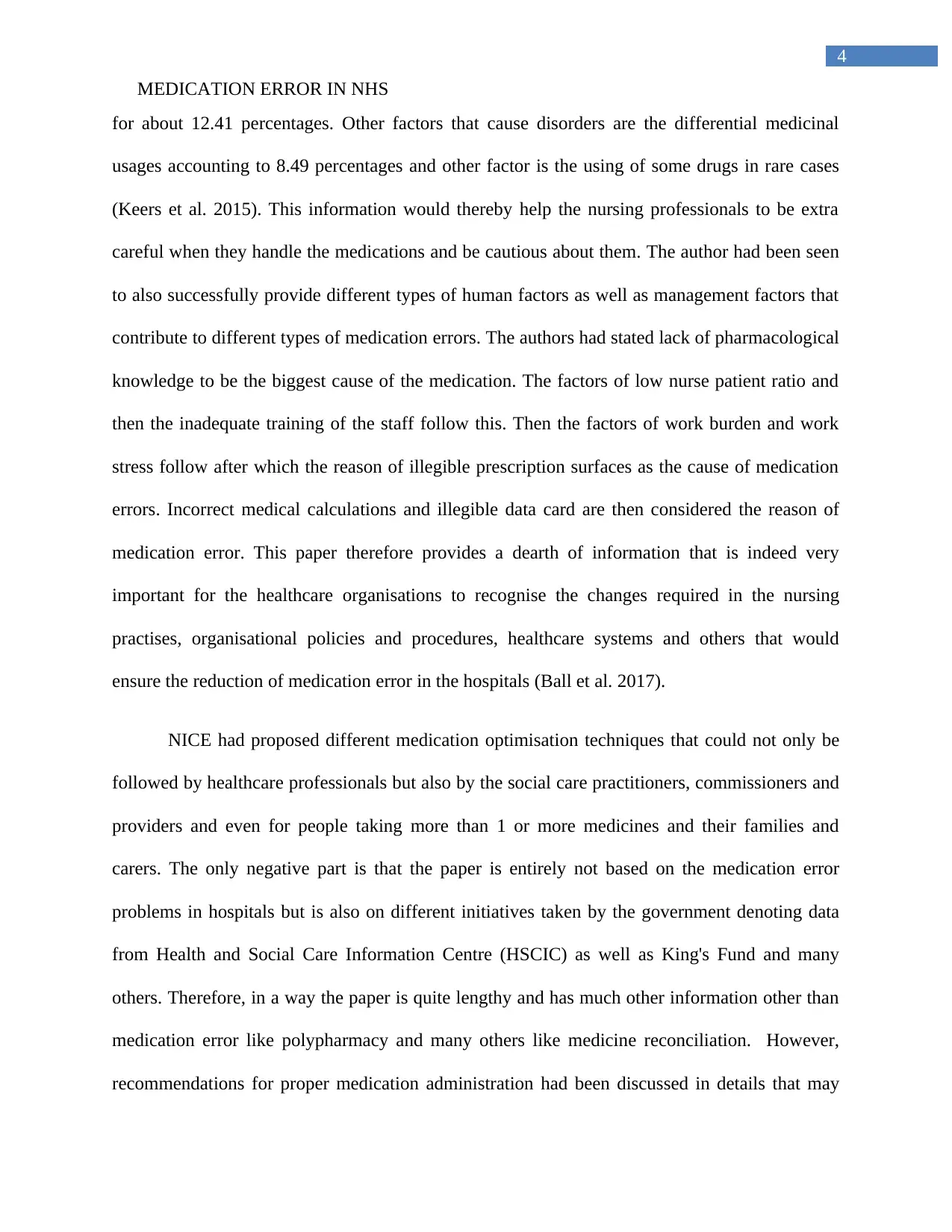
4
MEDICATION ERROR IN NHS
for about 12.41 percentages. Other factors that cause disorders are the differential medicinal
usages accounting to 8.49 percentages and other factor is the using of some drugs in rare cases
(Keers et al. 2015). This information would thereby help the nursing professionals to be extra
careful when they handle the medications and be cautious about them. The author had been seen
to also successfully provide different types of human factors as well as management factors that
contribute to different types of medication errors. The authors had stated lack of pharmacological
knowledge to be the biggest cause of the medication. The factors of low nurse patient ratio and
then the inadequate training of the staff follow this. Then the factors of work burden and work
stress follow after which the reason of illegible prescription surfaces as the cause of medication
errors. Incorrect medical calculations and illegible data card are then considered the reason of
medication error. This paper therefore provides a dearth of information that is indeed very
important for the healthcare organisations to recognise the changes required in the nursing
practises, organisational policies and procedures, healthcare systems and others that would
ensure the reduction of medication error in the hospitals (Ball et al. 2017).
NICE had proposed different medication optimisation techniques that could not only be
followed by healthcare professionals but also by the social care practitioners, commissioners and
providers and even for people taking more than 1 or more medicines and their families and
carers. The only negative part is that the paper is entirely not based on the medication error
problems in hospitals but is also on different initiatives taken by the government denoting data
from Health and Social Care Information Centre (HSCIC) as well as King's Fund and many
others. Therefore, in a way the paper is quite lengthy and has much other information other than
medication error like polypharmacy and many others like medicine reconciliation. However,
recommendations for proper medication administration had been discussed in details that may
MEDICATION ERROR IN NHS
for about 12.41 percentages. Other factors that cause disorders are the differential medicinal
usages accounting to 8.49 percentages and other factor is the using of some drugs in rare cases
(Keers et al. 2015). This information would thereby help the nursing professionals to be extra
careful when they handle the medications and be cautious about them. The author had been seen
to also successfully provide different types of human factors as well as management factors that
contribute to different types of medication errors. The authors had stated lack of pharmacological
knowledge to be the biggest cause of the medication. The factors of low nurse patient ratio and
then the inadequate training of the staff follow this. Then the factors of work burden and work
stress follow after which the reason of illegible prescription surfaces as the cause of medication
errors. Incorrect medical calculations and illegible data card are then considered the reason of
medication error. This paper therefore provides a dearth of information that is indeed very
important for the healthcare organisations to recognise the changes required in the nursing
practises, organisational policies and procedures, healthcare systems and others that would
ensure the reduction of medication error in the hospitals (Ball et al. 2017).
NICE had proposed different medication optimisation techniques that could not only be
followed by healthcare professionals but also by the social care practitioners, commissioners and
providers and even for people taking more than 1 or more medicines and their families and
carers. The only negative part is that the paper is entirely not based on the medication error
problems in hospitals but is also on different initiatives taken by the government denoting data
from Health and Social Care Information Centre (HSCIC) as well as King's Fund and many
others. Therefore, in a way the paper is quite lengthy and has much other information other than
medication error like polypharmacy and many others like medicine reconciliation. However,
recommendations for proper medication administration had been discussed in details that may
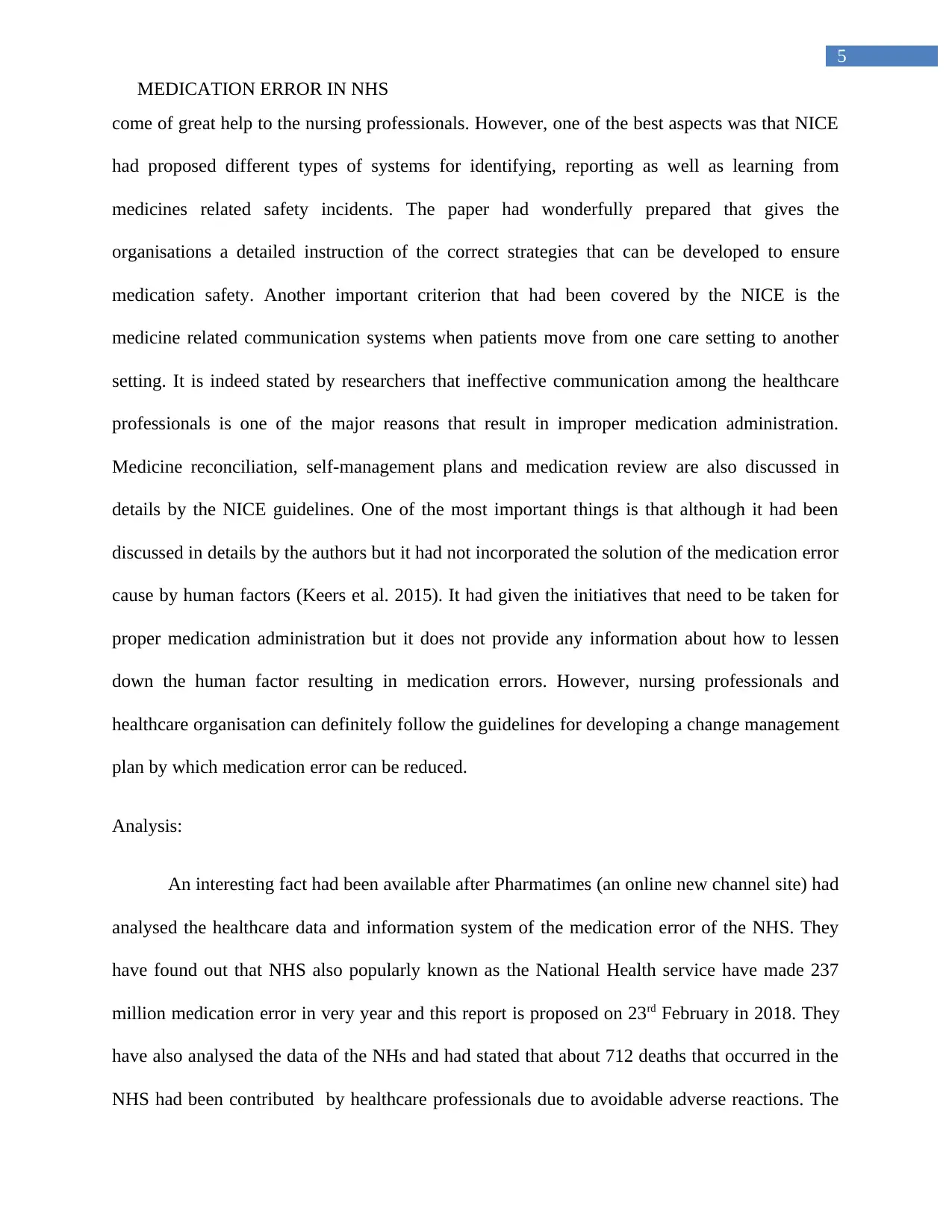
5
MEDICATION ERROR IN NHS
come of great help to the nursing professionals. However, one of the best aspects was that NICE
had proposed different types of systems for identifying, reporting as well as learning from
medicines related safety incidents. The paper had wonderfully prepared that gives the
organisations a detailed instruction of the correct strategies that can be developed to ensure
medication safety. Another important criterion that had been covered by the NICE is the
medicine related communication systems when patients move from one care setting to another
setting. It is indeed stated by researchers that ineffective communication among the healthcare
professionals is one of the major reasons that result in improper medication administration.
Medicine reconciliation, self-management plans and medication review are also discussed in
details by the NICE guidelines. One of the most important things is that although it had been
discussed in details by the authors but it had not incorporated the solution of the medication error
cause by human factors (Keers et al. 2015). It had given the initiatives that need to be taken for
proper medication administration but it does not provide any information about how to lessen
down the human factor resulting in medication errors. However, nursing professionals and
healthcare organisation can definitely follow the guidelines for developing a change management
plan by which medication error can be reduced.
Analysis:
An interesting fact had been available after Pharmatimes (an online new channel site) had
analysed the healthcare data and information system of the medication error of the NHS. They
have found out that NHS also popularly known as the National Health service have made 237
million medication error in very year and this report is proposed on 23rd February in 2018. They
have also analysed the data of the NHs and had stated that about 712 deaths that occurred in the
NHS had been contributed by healthcare professionals due to avoidable adverse reactions. The
MEDICATION ERROR IN NHS
come of great help to the nursing professionals. However, one of the best aspects was that NICE
had proposed different types of systems for identifying, reporting as well as learning from
medicines related safety incidents. The paper had wonderfully prepared that gives the
organisations a detailed instruction of the correct strategies that can be developed to ensure
medication safety. Another important criterion that had been covered by the NICE is the
medicine related communication systems when patients move from one care setting to another
setting. It is indeed stated by researchers that ineffective communication among the healthcare
professionals is one of the major reasons that result in improper medication administration.
Medicine reconciliation, self-management plans and medication review are also discussed in
details by the NICE guidelines. One of the most important things is that although it had been
discussed in details by the authors but it had not incorporated the solution of the medication error
cause by human factors (Keers et al. 2015). It had given the initiatives that need to be taken for
proper medication administration but it does not provide any information about how to lessen
down the human factor resulting in medication errors. However, nursing professionals and
healthcare organisation can definitely follow the guidelines for developing a change management
plan by which medication error can be reduced.
Analysis:
An interesting fact had been available after Pharmatimes (an online new channel site) had
analysed the healthcare data and information system of the medication error of the NHS. They
have found out that NHS also popularly known as the National Health service have made 237
million medication error in very year and this report is proposed on 23rd February in 2018. They
have also analysed the data of the NHs and had stated that about 712 deaths that occurred in the
NHS had been contributed by healthcare professionals due to avoidable adverse reactions. The
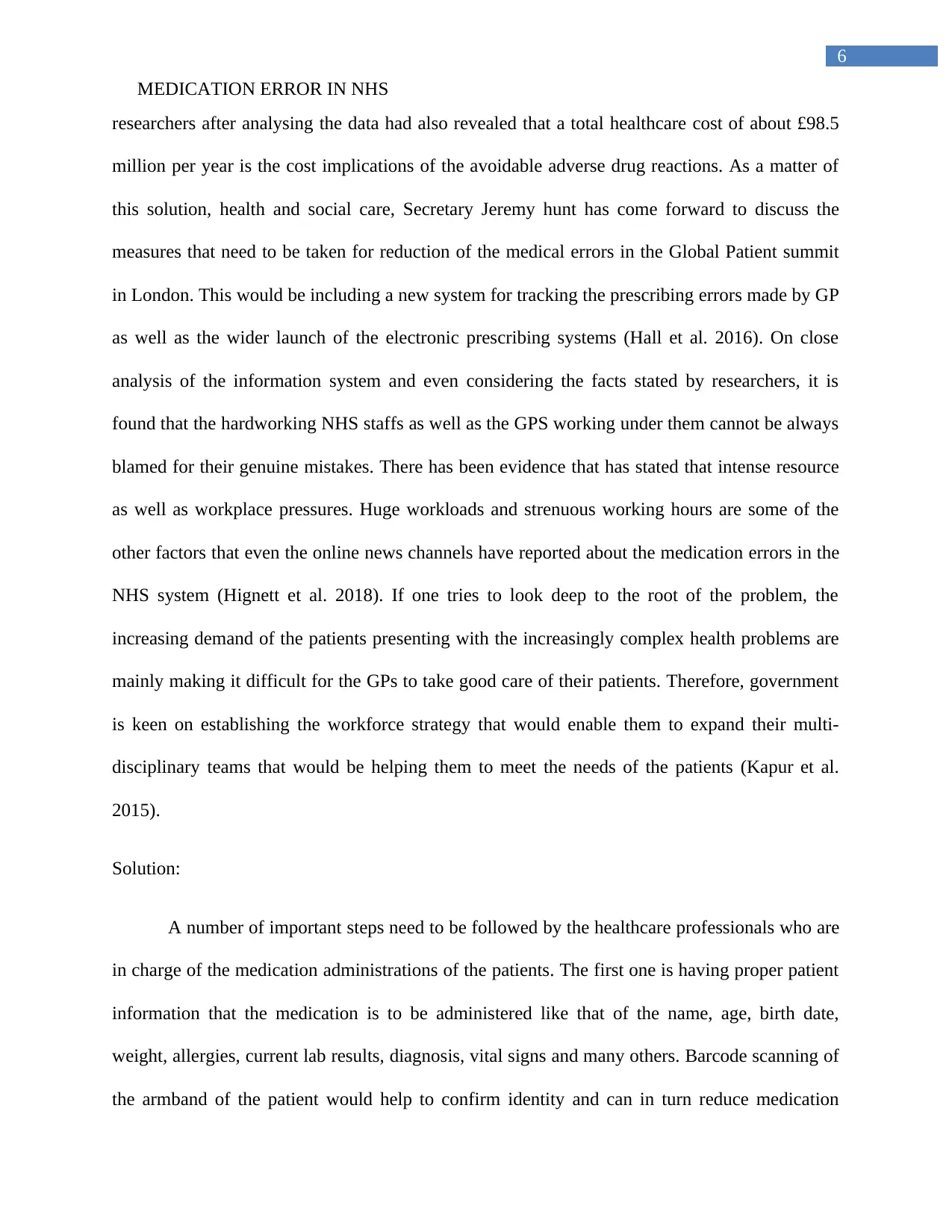
6
MEDICATION ERROR IN NHS
researchers after analysing the data had also revealed that a total healthcare cost of about £98.5
million per year is the cost implications of the avoidable adverse drug reactions. As a matter of
this solution, health and social care, Secretary Jeremy hunt has come forward to discuss the
measures that need to be taken for reduction of the medical errors in the Global Patient summit
in London. This would be including a new system for tracking the prescribing errors made by GP
as well as the wider launch of the electronic prescribing systems (Hall et al. 2016). On close
analysis of the information system and even considering the facts stated by researchers, it is
found that the hardworking NHS staffs as well as the GPS working under them cannot be always
blamed for their genuine mistakes. There has been evidence that has stated that intense resource
as well as workplace pressures. Huge workloads and strenuous working hours are some of the
other factors that even the online news channels have reported about the medication errors in the
NHS system (Hignett et al. 2018). If one tries to look deep to the root of the problem, the
increasing demand of the patients presenting with the increasingly complex health problems are
mainly making it difficult for the GPs to take good care of their patients. Therefore, government
is keen on establishing the workforce strategy that would enable them to expand their multi-
disciplinary teams that would be helping them to meet the needs of the patients (Kapur et al.
2015).
Solution:
A number of important steps need to be followed by the healthcare professionals who are
in charge of the medication administrations of the patients. The first one is having proper patient
information that the medication is to be administered like that of the name, age, birth date,
weight, allergies, current lab results, diagnosis, vital signs and many others. Barcode scanning of
the armband of the patient would help to confirm identity and can in turn reduce medication
MEDICATION ERROR IN NHS
researchers after analysing the data had also revealed that a total healthcare cost of about £98.5
million per year is the cost implications of the avoidable adverse drug reactions. As a matter of
this solution, health and social care, Secretary Jeremy hunt has come forward to discuss the
measures that need to be taken for reduction of the medical errors in the Global Patient summit
in London. This would be including a new system for tracking the prescribing errors made by GP
as well as the wider launch of the electronic prescribing systems (Hall et al. 2016). On close
analysis of the information system and even considering the facts stated by researchers, it is
found that the hardworking NHS staffs as well as the GPS working under them cannot be always
blamed for their genuine mistakes. There has been evidence that has stated that intense resource
as well as workplace pressures. Huge workloads and strenuous working hours are some of the
other factors that even the online news channels have reported about the medication errors in the
NHS system (Hignett et al. 2018). If one tries to look deep to the root of the problem, the
increasing demand of the patients presenting with the increasingly complex health problems are
mainly making it difficult for the GPs to take good care of their patients. Therefore, government
is keen on establishing the workforce strategy that would enable them to expand their multi-
disciplinary teams that would be helping them to meet the needs of the patients (Kapur et al.
2015).
Solution:
A number of important steps need to be followed by the healthcare professionals who are
in charge of the medication administrations of the patients. The first one is having proper patient
information that the medication is to be administered like that of the name, age, birth date,
weight, allergies, current lab results, diagnosis, vital signs and many others. Barcode scanning of
the armband of the patient would help to confirm identity and can in turn reduce medication
Paraphrase This Document
Need a fresh take? Get an instant paraphrase of this document with our AI Paraphraser
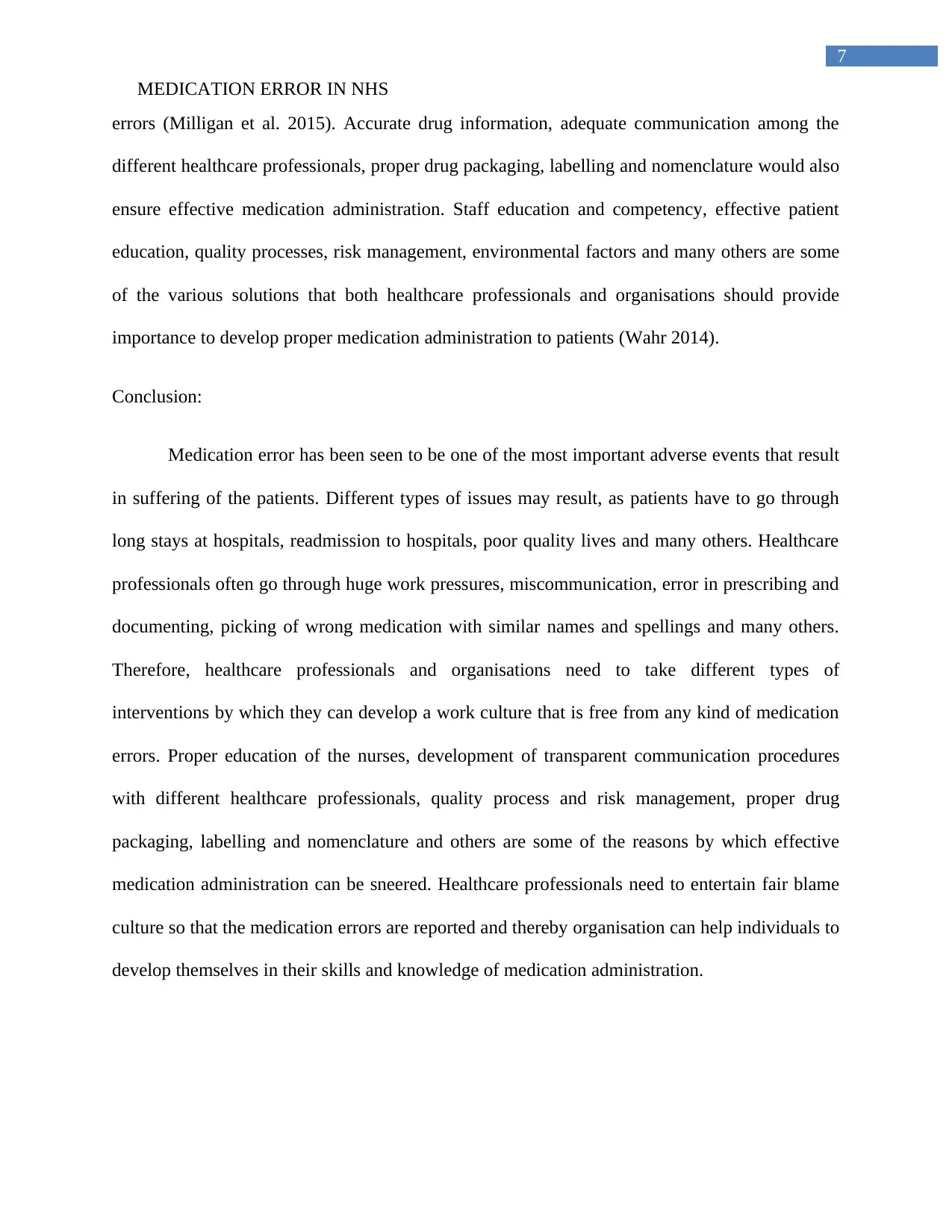
7
MEDICATION ERROR IN NHS
errors (Milligan et al. 2015). Accurate drug information, adequate communication among the
different healthcare professionals, proper drug packaging, labelling and nomenclature would also
ensure effective medication administration. Staff education and competency, effective patient
education, quality processes, risk management, environmental factors and many others are some
of the various solutions that both healthcare professionals and organisations should provide
importance to develop proper medication administration to patients (Wahr 2014).
Conclusion:
Medication error has been seen to be one of the most important adverse events that result
in suffering of the patients. Different types of issues may result, as patients have to go through
long stays at hospitals, readmission to hospitals, poor quality lives and many others. Healthcare
professionals often go through huge work pressures, miscommunication, error in prescribing and
documenting, picking of wrong medication with similar names and spellings and many others.
Therefore, healthcare professionals and organisations need to take different types of
interventions by which they can develop a work culture that is free from any kind of medication
errors. Proper education of the nurses, development of transparent communication procedures
with different healthcare professionals, quality process and risk management, proper drug
packaging, labelling and nomenclature and others are some of the reasons by which effective
medication administration can be sneered. Healthcare professionals need to entertain fair blame
culture so that the medication errors are reported and thereby organisation can help individuals to
develop themselves in their skills and knowledge of medication administration.
MEDICATION ERROR IN NHS
errors (Milligan et al. 2015). Accurate drug information, adequate communication among the
different healthcare professionals, proper drug packaging, labelling and nomenclature would also
ensure effective medication administration. Staff education and competency, effective patient
education, quality processes, risk management, environmental factors and many others are some
of the various solutions that both healthcare professionals and organisations should provide
importance to develop proper medication administration to patients (Wahr 2014).
Conclusion:
Medication error has been seen to be one of the most important adverse events that result
in suffering of the patients. Different types of issues may result, as patients have to go through
long stays at hospitals, readmission to hospitals, poor quality lives and many others. Healthcare
professionals often go through huge work pressures, miscommunication, error in prescribing and
documenting, picking of wrong medication with similar names and spellings and many others.
Therefore, healthcare professionals and organisations need to take different types of
interventions by which they can develop a work culture that is free from any kind of medication
errors. Proper education of the nurses, development of transparent communication procedures
with different healthcare professionals, quality process and risk management, proper drug
packaging, labelling and nomenclature and others are some of the reasons by which effective
medication administration can be sneered. Healthcare professionals need to entertain fair blame
culture so that the medication errors are reported and thereby organisation can help individuals to
develop themselves in their skills and knowledge of medication administration.
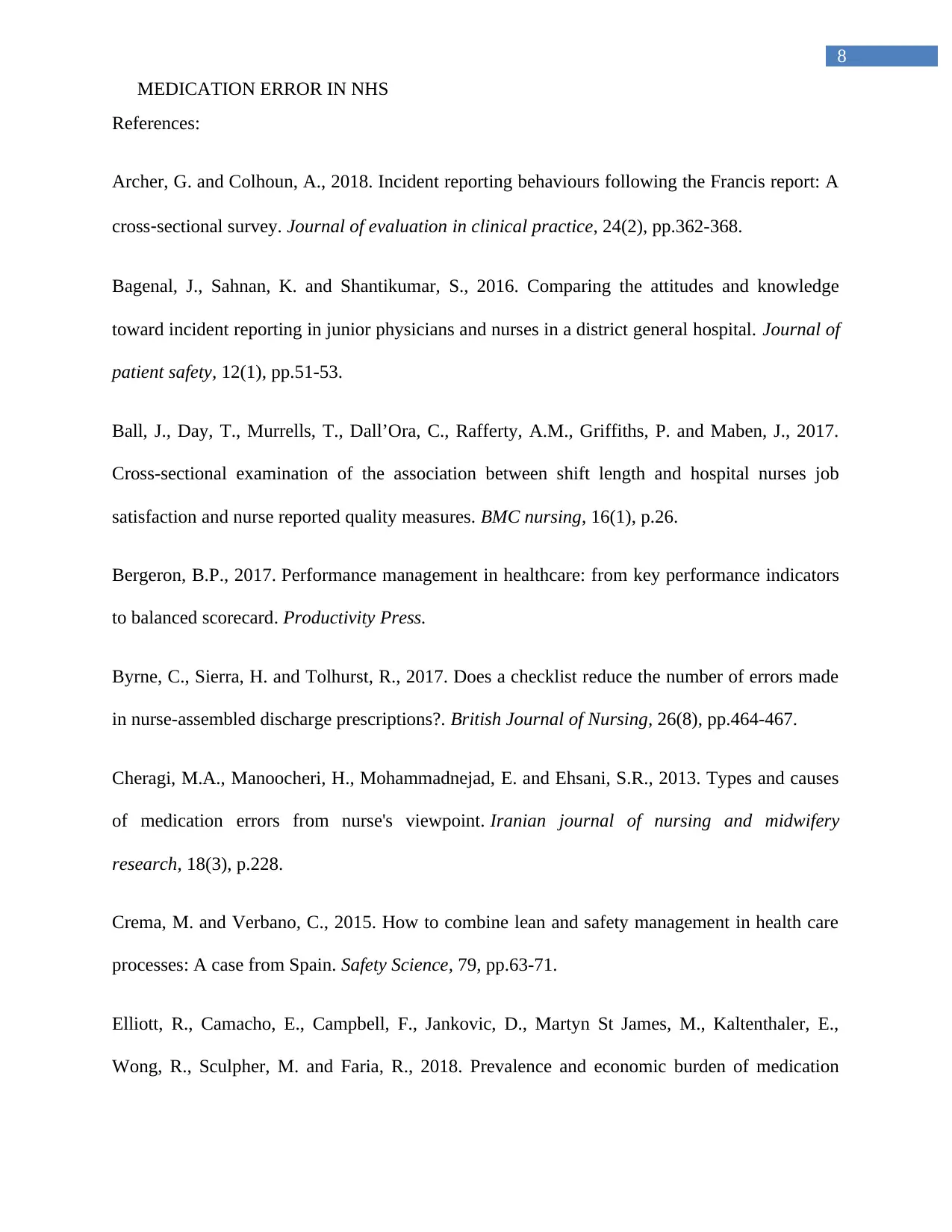
8
MEDICATION ERROR IN NHS
References:
Archer, G. and Colhoun, A., 2018. Incident reporting behaviours following the Francis report: A
cross‐sectional survey. Journal of evaluation in clinical practice, 24(2), pp.362-368.
Bagenal, J., Sahnan, K. and Shantikumar, S., 2016. Comparing the attitudes and knowledge
toward incident reporting in junior physicians and nurses in a district general hospital. Journal of
patient safety, 12(1), pp.51-53.
Ball, J., Day, T., Murrells, T., Dall’Ora, C., Rafferty, A.M., Griffiths, P. and Maben, J., 2017.
Cross-sectional examination of the association between shift length and hospital nurses job
satisfaction and nurse reported quality measures. BMC nursing, 16(1), p.26.
Bergeron, B.P., 2017. Performance management in healthcare: from key performance indicators
to balanced scorecard. Productivity Press.
Byrne, C., Sierra, H. and Tolhurst, R., 2017. Does a checklist reduce the number of errors made
in nurse-assembled discharge prescriptions?. British Journal of Nursing, 26(8), pp.464-467.
Cheragi, M.A., Manoocheri, H., Mohammadnejad, E. and Ehsani, S.R., 2013. Types and causes
of medication errors from nurse's viewpoint. Iranian journal of nursing and midwifery
research, 18(3), p.228.
Crema, M. and Verbano, C., 2015. How to combine lean and safety management in health care
processes: A case from Spain. Safety Science, 79, pp.63-71.
Elliott, R., Camacho, E., Campbell, F., Jankovic, D., Martyn St James, M., Kaltenthaler, E.,
Wong, R., Sculpher, M. and Faria, R., 2018. Prevalence and economic burden of medication
MEDICATION ERROR IN NHS
References:
Archer, G. and Colhoun, A., 2018. Incident reporting behaviours following the Francis report: A
cross‐sectional survey. Journal of evaluation in clinical practice, 24(2), pp.362-368.
Bagenal, J., Sahnan, K. and Shantikumar, S., 2016. Comparing the attitudes and knowledge
toward incident reporting in junior physicians and nurses in a district general hospital. Journal of
patient safety, 12(1), pp.51-53.
Ball, J., Day, T., Murrells, T., Dall’Ora, C., Rafferty, A.M., Griffiths, P. and Maben, J., 2017.
Cross-sectional examination of the association between shift length and hospital nurses job
satisfaction and nurse reported quality measures. BMC nursing, 16(1), p.26.
Bergeron, B.P., 2017. Performance management in healthcare: from key performance indicators
to balanced scorecard. Productivity Press.
Byrne, C., Sierra, H. and Tolhurst, R., 2017. Does a checklist reduce the number of errors made
in nurse-assembled discharge prescriptions?. British Journal of Nursing, 26(8), pp.464-467.
Cheragi, M.A., Manoocheri, H., Mohammadnejad, E. and Ehsani, S.R., 2013. Types and causes
of medication errors from nurse's viewpoint. Iranian journal of nursing and midwifery
research, 18(3), p.228.
Crema, M. and Verbano, C., 2015. How to combine lean and safety management in health care
processes: A case from Spain. Safety Science, 79, pp.63-71.
Elliott, R., Camacho, E., Campbell, F., Jankovic, D., Martyn St James, M., Kaltenthaler, E.,
Wong, R., Sculpher, M. and Faria, R., 2018. Prevalence and economic burden of medication
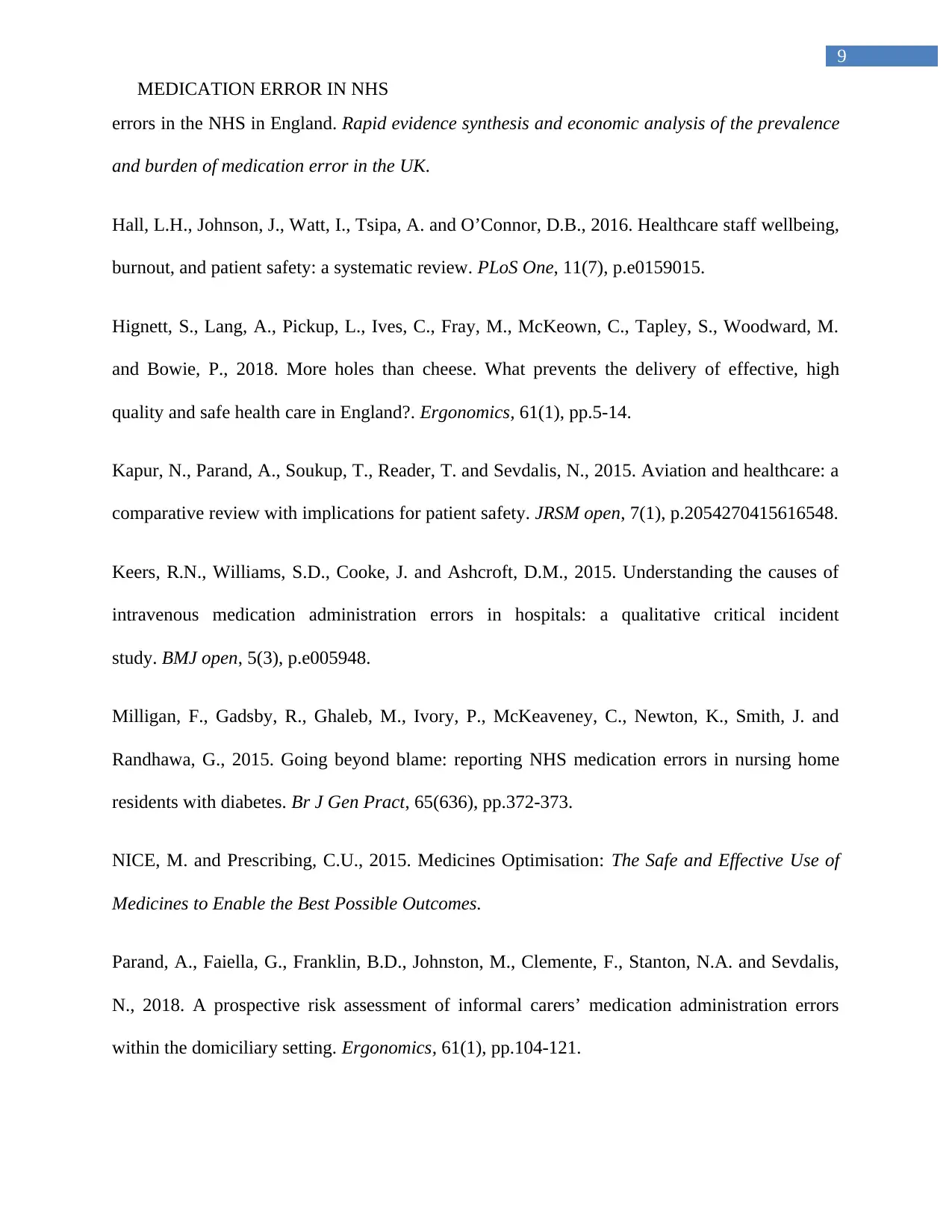
9
MEDICATION ERROR IN NHS
errors in the NHS in England. Rapid evidence synthesis and economic analysis of the prevalence
and burden of medication error in the UK.
Hall, L.H., Johnson, J., Watt, I., Tsipa, A. and O’Connor, D.B., 2016. Healthcare staff wellbeing,
burnout, and patient safety: a systematic review. PLoS One, 11(7), p.e0159015.
Hignett, S., Lang, A., Pickup, L., Ives, C., Fray, M., McKeown, C., Tapley, S., Woodward, M.
and Bowie, P., 2018. More holes than cheese. What prevents the delivery of effective, high
quality and safe health care in England?. Ergonomics, 61(1), pp.5-14.
Kapur, N., Parand, A., Soukup, T., Reader, T. and Sevdalis, N., 2015. Aviation and healthcare: a
comparative review with implications for patient safety. JRSM open, 7(1), p.2054270415616548.
Keers, R.N., Williams, S.D., Cooke, J. and Ashcroft, D.M., 2015. Understanding the causes of
intravenous medication administration errors in hospitals: a qualitative critical incident
study. BMJ open, 5(3), p.e005948.
Milligan, F., Gadsby, R., Ghaleb, M., Ivory, P., McKeaveney, C., Newton, K., Smith, J. and
Randhawa, G., 2015. Going beyond blame: reporting NHS medication errors in nursing home
residents with diabetes. Br J Gen Pract, 65(636), pp.372-373.
NICE, M. and Prescribing, C.U., 2015. Medicines Optimisation: The Safe and Effective Use of
Medicines to Enable the Best Possible Outcomes.
Parand, A., Faiella, G., Franklin, B.D., Johnston, M., Clemente, F., Stanton, N.A. and Sevdalis,
N., 2018. A prospective risk assessment of informal carers’ medication administration errors
within the domiciliary setting. Ergonomics, 61(1), pp.104-121.
MEDICATION ERROR IN NHS
errors in the NHS in England. Rapid evidence synthesis and economic analysis of the prevalence
and burden of medication error in the UK.
Hall, L.H., Johnson, J., Watt, I., Tsipa, A. and O’Connor, D.B., 2016. Healthcare staff wellbeing,
burnout, and patient safety: a systematic review. PLoS One, 11(7), p.e0159015.
Hignett, S., Lang, A., Pickup, L., Ives, C., Fray, M., McKeown, C., Tapley, S., Woodward, M.
and Bowie, P., 2018. More holes than cheese. What prevents the delivery of effective, high
quality and safe health care in England?. Ergonomics, 61(1), pp.5-14.
Kapur, N., Parand, A., Soukup, T., Reader, T. and Sevdalis, N., 2015. Aviation and healthcare: a
comparative review with implications for patient safety. JRSM open, 7(1), p.2054270415616548.
Keers, R.N., Williams, S.D., Cooke, J. and Ashcroft, D.M., 2015. Understanding the causes of
intravenous medication administration errors in hospitals: a qualitative critical incident
study. BMJ open, 5(3), p.e005948.
Milligan, F., Gadsby, R., Ghaleb, M., Ivory, P., McKeaveney, C., Newton, K., Smith, J. and
Randhawa, G., 2015. Going beyond blame: reporting NHS medication errors in nursing home
residents with diabetes. Br J Gen Pract, 65(636), pp.372-373.
NICE, M. and Prescribing, C.U., 2015. Medicines Optimisation: The Safe and Effective Use of
Medicines to Enable the Best Possible Outcomes.
Parand, A., Faiella, G., Franklin, B.D., Johnston, M., Clemente, F., Stanton, N.A. and Sevdalis,
N., 2018. A prospective risk assessment of informal carers’ medication administration errors
within the domiciliary setting. Ergonomics, 61(1), pp.104-121.
Secure Best Marks with AI Grader
Need help grading? Try our AI Grader for instant feedback on your assignments.
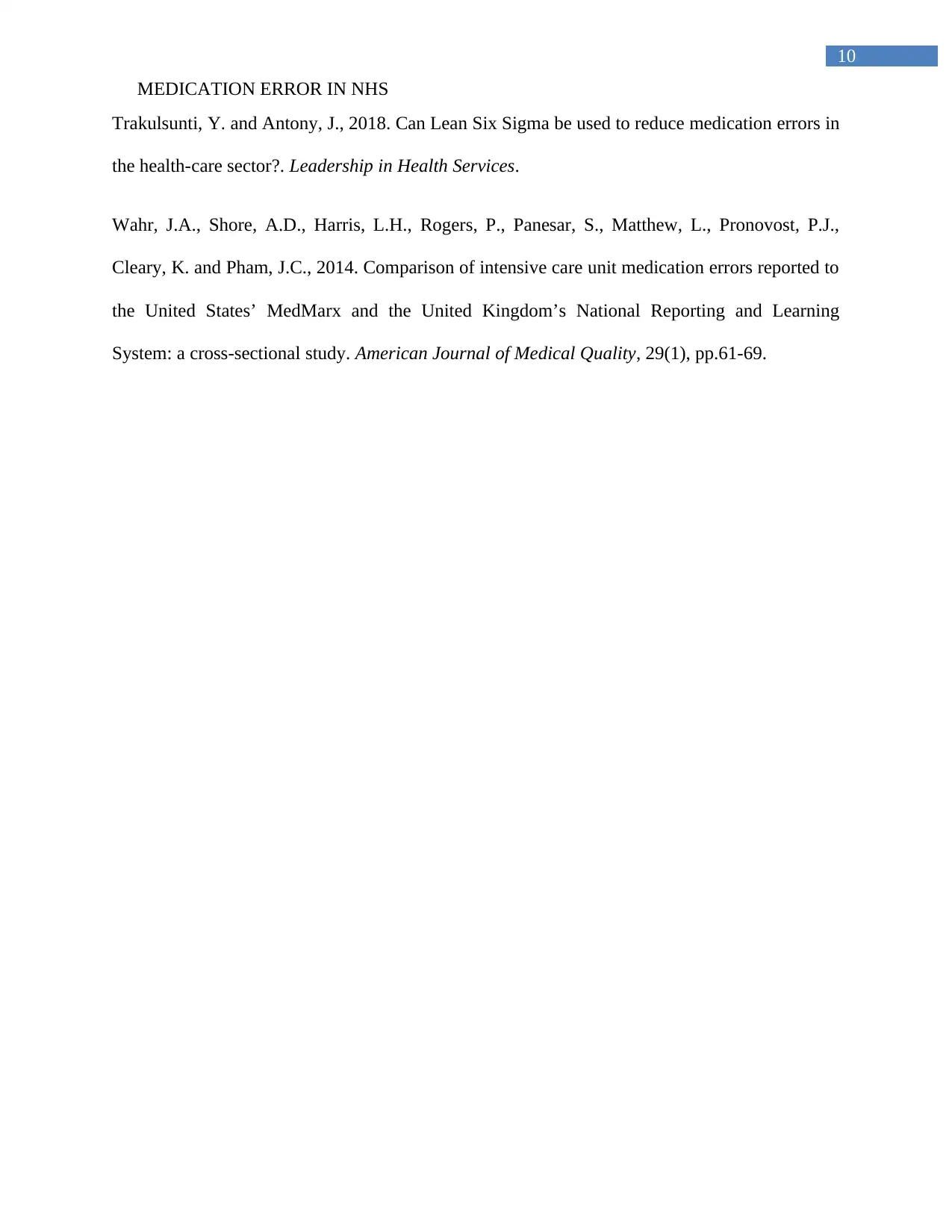
10
MEDICATION ERROR IN NHS
Trakulsunti, Y. and Antony, J., 2018. Can Lean Six Sigma be used to reduce medication errors in
the health-care sector?. Leadership in Health Services.
Wahr, J.A., Shore, A.D., Harris, L.H., Rogers, P., Panesar, S., Matthew, L., Pronovost, P.J.,
Cleary, K. and Pham, J.C., 2014. Comparison of intensive care unit medication errors reported to
the United States’ MedMarx and the United Kingdom’s National Reporting and Learning
System: a cross-sectional study. American Journal of Medical Quality, 29(1), pp.61-69.
MEDICATION ERROR IN NHS
Trakulsunti, Y. and Antony, J., 2018. Can Lean Six Sigma be used to reduce medication errors in
the health-care sector?. Leadership in Health Services.
Wahr, J.A., Shore, A.D., Harris, L.H., Rogers, P., Panesar, S., Matthew, L., Pronovost, P.J.,
Cleary, K. and Pham, J.C., 2014. Comparison of intensive care unit medication errors reported to
the United States’ MedMarx and the United Kingdom’s National Reporting and Learning
System: a cross-sectional study. American Journal of Medical Quality, 29(1), pp.61-69.
1 out of 11
Related Documents
Your All-in-One AI-Powered Toolkit for Academic Success.
+13062052269
info@desklib.com
Available 24*7 on WhatsApp / Email
![[object Object]](/_next/static/media/star-bottom.7253800d.svg)
Unlock your academic potential
© 2024 | Zucol Services PVT LTD | All rights reserved.





